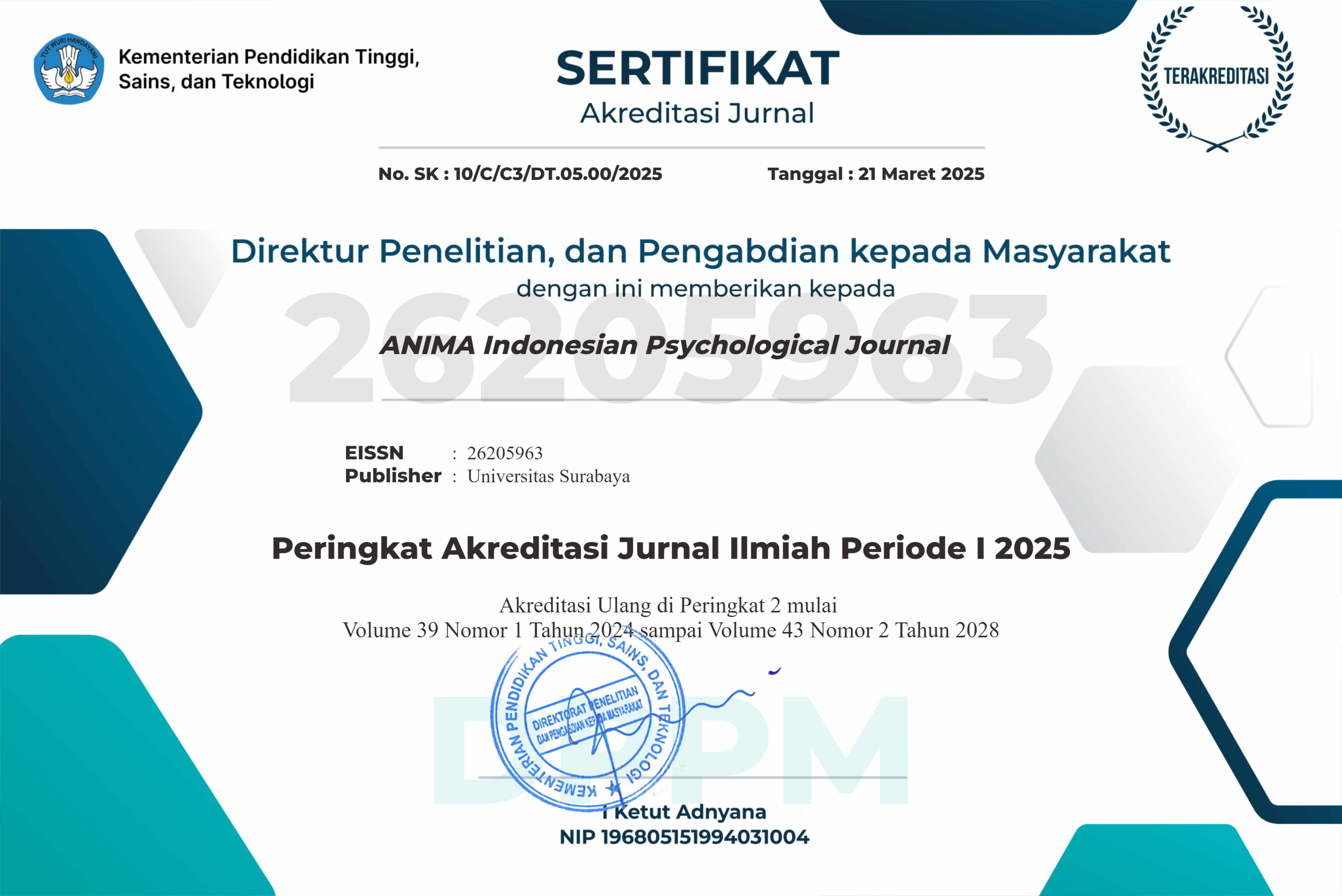Latent Profiles of Depressive Symptoms Among Indonesian Adolescents: Evidence from the Indonesia Family Life Survey 5 (IFLS-5)
 Abstract Views:
663 times
Abstract Views:
663 times
 PDF - Full Text Downloads:
140 times
PDF - Full Text Downloads:
140 times
Abstract
Adolescent depression is a major public health issue, yet there is limited study on depressive symptoms among Indonesian adolescents. Identifying distinct subgroups within this population could help inform targeted prevention and intervention efforts. This study analyzed data from the Indonesia Family Life Survey 5 (IFLS-5) utilizing Latent Profile Analysis (LPA) to identify depressive symptom subgroups. Chi-Square Tests were utilized for univariate analysis, and Logistic Regression Analysis examined associated factors. Among 2,267 adolescents, two symptom profiles emerged: (1) “Low-Level” Depressive Symptoms Profile (73.31%); and (2) “High-Level” Depressive Symptoms Profile (26.69%). Sex or gender was the only significant factor in the univariate analysis, with Logistic Regression Analysis revealing that female adolescents were more likely to exhibit high levels of depressive symptoms. These findings suggest that female adolescents are at greater risk for more severe depressive symptoms, highlighting the need for targeted prevention and intervention strategies.
Downloads
References
Alloy, L. B., Hamilton, J. L., Hamlat, E. J., & Abramson, L. Y. (2016). Pubertal development, emotion regulatory styles, and the emergence of sex differences in internalizing disorders and symptoms in adolescence. Clinical Psychological Science, 4(5), 867-881. https://doi.org/10.1177/2167702616643008
Andresen, E. M., Malmgren, J. A., Carter, W. B., & Patrick, D. L. (1994). Screening for depression in well older adults: Evaluation of a short form of the CES-D. American Journal of Preventive Medicine, 10(2), 77-84. https://doi.org/10.1016/S0749-3797(18)30622-6
Andresen, E. M., Byers, K., Friary, J., Kosloski, K., & Montgomery, R. (2014). Performance of the 10-item Center for Epidemiologic Studies Depression scale for caregiving research. SAGE Open Medicine, 1: 2050312113514576. https://doi.org/10.1177/2050312113514576
Arnett J. J. (2000). Emerging adulthood: A theory of development from the late teens through the twenties. American Psychologist, 55(5), 469-480. https://doi.org/10.1037/0003-066X.55.5.469
Apicella, M., Serra, G., Iannoni, M. E., Trasolini, M., Maglio, G., Andracchio, E., & Vicari, S. (2023). Gender differences in the psychopathology of mixed depression in adolescents with a major depressive episode. Current Neuropharmacology, 21(6), 1343-1354. https://doi.org/10.2174/1570159X20666221012113458
Bakker J. (2019). The sexual differentiation of the human brain: Role of sex hormones versus sex chromosomes. In L. M. Coolen, & D. R. Grattan (Eds.), Neuroendocrine regulation of behavior (vol. 43, pp. 45-67). Springer Cham. https://doi.org/10.1007/7854_2018_70
Björgvinsson, T., Kertz, S. J., Bigda-Peyton, J. S., McCoy, K. L., & Aderka, I. M. (2013). Psychometric properties of the CES-D-10 in a psychiatric sample. Assessment, 20(4), 429-436. https://doi.org/10.1177/1073191113481998
Borsboom, D., Deserno, M. K., Rhemtulla, M., Epskamp, S., Fried, E. I., McNally, R. J., Robinaugh, D. J., Perugini, M., Dalege, J., Costantini, G., Isvoranu, A. -M., Wysocki, A. C., van Borkulo, C. D., van Bork, R., & Waldorp, L. J. (2021). Network analysis of multivariate data in psychological science. Nature Reviews Methods Primers, 1: 58. https://doi.org/10.1038/s43586-021-00055-w
Cleophas, T. J. (2012). Machine learning in pharmaceutical research: Data clustering, why so and how so. Journal of Pharmaceutical Sciences and Research (JPSR), 4(11), 1964-1969. https://www.pharmainfo.in/jpsr/Documents/Volumes/vol4issue11/jpsr%2004121103.pdf
Conway, C. C., Li, Y. I., & Starr, L. R. (2019). Trait anhedonia is a transdiagnostic correlate of internalizing problems during adolescence. Journal of Research in Personality, 81, 56-63. https://doi.org/10.1016/j.jrp.2019.05.004
Cuijpers, P., & Smit, F. (2008). Subklinische depressie: Een klinisch relevante conditie? [Subclinical depression: A clinically relevant condition?]. Tijdschrift voor Psychiatrie [Journal of Psychiatry], 50(8), 519-528. https://www.tijdschriftvoorpsychiatrie.nl/nl/tijdschrift/issue/2008/8/50-1785_Subklinische-depressie-een-klinisch-relevante-conditie
Culpepper L. (2015). Impact of untreated major depressive disorder on cognition and daily function. The Journal of Clinical Psychiatry, 76(7): e901. https://doi.org/10.4088/JCP.13086tx4c
Duthie, G., Reavley, N., Wright, J., & Morgan, A. (2024). The impact of media-based mental health campaigns on male help-seeking: A systematic review. Health Promotion International, 39(4): daae104. https://doi.org/10.1093/heapro/daae104
Eapen, V., & Črnčec, R. (2012). Strategies and challenges in the management of adolescent depression. Current Opinion in Psychiatry, 25(1), 7-13. https://doi.org/10.1097/YCO.0b013e32834de3bd
Eschenbeck, H., Kohlmann, C. -W., & Lohaus, A. (2007). Gender differences in coping strategies in children and adolescents. Journal of Individual Differences, 28(1), 18-26. https://doi.org/10.1027/1614-0001.28.1.18
Fava, G. A., & Tossani, E. (2007). Prodromal stage of major depression. Early Intervention in Psychiatry, 1(1), 9-18. https://doi.org/10.1111/j.1751-7893.2007.00005.x
Ferrari, M., Hunt, C., Harrysunker, A., Abbott, M. J., Beath, A. P., & Einstein, D. A. (2019). Self-compassion interventions and psychosocial outcomes: A meta-analysis of RCTs. Mindfulness, 10(8), 1455-1473. https://doi.org/10.1007/s12671-019-01134-6
Frost, A., Hoyt, L. T., Chung, A. L., & Adam, E. K. (2015). Daily life with depressive symptoms: Gender differences in adolescents’ everyday emotional experiences. Journal of Adolescence, 43(1), 132-141. https://doi.org/10.1016/j.adolescence.2015.06.001
Hankin, B. L., Abramson, L. Y., Moffitt, T. E., Silva, P. A., McGee, R., & Angell, K. E. (1998). Development of depression from preadolescence to young adulthood: Emerging gender differences in a 10-year longitudinal study. Journal of Abnormal Psychology, 107(1), 128-140. https://doi.org/10.1037//0021-843x.107.1.128
Hartini, N., Fardana, N. A., Ariana, A. D., & Wardana, N. D. (2018). Stigma toward people with mental health problems in Indonesia. Psychology Research and Behavior Management, 11, 535-541. https://doi.org/10.2147/PRBM.S175251
Hawton, K., Casañas i Comabella, C., Haw, C., & Saunders, K. (2013). Risk factors for suicide in individuals with depression: A systematic review. Journal of Affective Disorders, 147(1-3), 17-28. https://doi.org/10.1016/j.jad.2013.01.004
Humensky, J., Kuwabara, S. A., Fogel, J., Wells, C., Goodwin, B., & Van Voorhees, B. W. (2010). Adolescents with depressive symptoms and their challenges with learning in school. The Journal of School Nursing, 26(5), 377-392. https://doi.org/10.1177/1059840510376515
Idris, H., & Tuzzahra, F. (2023). Factors associated with depressive symptoms among adolescents in Indonesia: A cross-sectional study of results from the Indonesia Family Life Survey. Malaysian Family Physician, 18: 29. https://doi.org/10.51866/oa.265
James, C., Powell, M., Seixas, A., Bateman, A., Pengpid, S., & Peltzer, K. (2020). Exploring the psychometric properties of the CES-D-10 and its practicality in detecting depressive symptomatology in 27 low- and middle-income countries. International Journal of Psychology, 55(3), 435-445. https://doi.org/10.1002/ijop.12613
Jaya, E. S., Novrianto, R., Pillny, M., & Wiguna, T. (2024). Indonesian Patient Health Questionnaire’s clinical utility in psychiatric outpatients: Ruling out conditions per ICD-11 criteria. Asian Journal of Psychiatry, 100: 104184. https://doi.org/10.1016/j.ajp.2024.104184
Jaycox, L. H., Stein, B. D., Paddock, S., Miles, J. N. V., Chandra, A., Meredith, L. S., Tanielian, T., Hickey, S., & Burnam, M. A. (2009). Impact of teen depression on academic, social, and physical functioning. Pediatrics, 124(4), e596-e605. https://doi.org/10.1542/peds.2008-3348
Joormann, J., & Tanovic, E. (2015). Cognitive vulnerability to depression: Examining cognitive control and emotion regulation. Current Opinion in Psychology, 4, 86-92. https://doi.org/10.1016/j.copsyc.2014.12.006
Joormann, J., & Siemer, M. (2011). Affective processing and emotion regulation in dysphoria and depression: Cognitive biases and deficits in cognitive control. Social and Personality Psychology Compass, 5(1), 13-28. https://doi.org/10.1111/j.1751-9004.2010.00335.x
Karsten, J., Penninx, B. W. J., Verboom, C. E., Nolen, W. A., & Hartman, C. A. (2013). Course and risk factors of functional impairment in subthreshold depression and anxiety. Depression and Anxiety, 30(4), 386-394. https://doi.org/10.1002/da.22021
Kelly, M. M., Tyrka, A. R., Price, L. H., & Carpenter, L. L. (2008). Sex differences in the use of coping strategies: Predictors of anxiety and depressive symptoms. Depression and Anxiety, 25(10), 839-846. https://doi.org/10.1002/da.20341
Khairunnisa, M., Yunitawati, D., Latifah, L., Effendi, D. E., Fitrianti, Y., Handayani, S., & Kusumawardani, H. D. (2024). Rural-urban differences in common mental disorders among Indonesian youth: A cross-sectional national survey. Osong Public Health and Research Perspectives, 15(5), 440-450. https://doi.org/10.24171/j.phrp.2023.0385
Kleinman A. (2004). Culture and depression. The New England Journal of Medicine, 351(10), 951-953. https://doi.org/10.1056/NEJMp048078
Kroenke, K., Spitzer, R. L., & Williams, J. B. W. (2001). The PHQ-9: Validity of a brief depression severity measure. Journal of General Internal Medicine, 16(9), 606-613. https://doi.org/10.1046/j.1525-1497.2001.016009606.x
Langenecker, S. A., Westlund Schreiner, M., Bessette, K. L., Roberts, H., Thomas, L., Dillahunt, A., Pocius, S. L., Feldman, D. A., Jago, D., Farstead, B., Pazdera, M., Kaufman, E., Galloway, J. A., Kerig, P. K., Bakian, A., Welsh, R. C., Jacobs, R. H., Crowell, S. E., & Watkins, E. R. (2024). Rumination-focused cognitive behavioral therapy reduces rumination and targeted cross-network connectivity in youth with a history of depression: Replication in a preregistered randomized clinical trial. Biological Psychiatry Global Open Science, 4(1), 1-10. https://doi.org/10.1016/j.bpsgos.2023.08.012
Li, L., Sun, W., Luo, J., & Huang, H. (2022). Associations between education levels and prevalence of depressive symptoms: NHANES (2005-2018). Journal of Affective Disorders, 301, 360-367. https://doi.org/10.1016/j.jad.2022.01.010
Lim, J. -A., Yun, J. -Y., Choi, Y., Choi, S. -H., Kwon, Y., Lee, H. Y., & Jang, J. H. (2020). Sex-specific differences in severity of depressive symptoms, heart rate variability, and neurocognitive profiles of depressed young adults: Exploring characteristics for mild depression. Frontiers in Psychiatry, 11: 217. https://doi.org/10.3389/fpsyt.2020.00217
Maciejewski, D. F., Keijsers, L., van Lier, P. A. C., Branje, S. J. T., Meeus, W. H. J., & Koot, H. M. (2019). Most fare well—But some do not: Distinct profiles of mood variability development and their association with adjustment during adolescence. Developmental Psychology, 55(2), 434-448. https://doi.org/10.1037/dev0000650
MacIntosh, R. C., & Strickland, O. J. (2010). Differential item responses on CES-D inventory: A comparison of elderly Hispanics and non-Hispanic Whites in the United States and item usage by elderly Hispanics across time. Aging & Mental Health, 14(5), 556-564. https://doi.org/10.1080/13607860903421045
MacPhee, A. R., & Andrews, J. J. W. (2006). Risk factors for depression in early adolescence. Adolescence, 41(163), 435-466. https://psycnet.apa.org/record/2006-22303-003 | https://pubmed.ncbi.nlm.nih.gov/17225661/
Meisenzahl, E., Wege, N., Stegmüller, V., Schulte-Körne, G., Greimel, E., Dannlowski, U., Hahn, T., Romer, G., Romanos, M., Deserno, L., Klingele, C., Theisen, C., Kieckhäfer, C., Forstner, A., Ruhrmann, S., & Schultze-Lutter, F. (2024). Clinical high risk state of major depressive episodes: Assessment of prodromal phase, its occurrence, duration and symptom patterns by the instrument the DEpression Early Prediction-INventory (DEEP-IN). Journal of Affective Disorders, 351, 403-413. https://doi.org/10.1016/j.jad.2023.12.084
Miloseva, L., Vukosavljevic-Gvozden, T., Milosev, V., & Davis, T., III. (2018). Can we predict and prevent subclinical depression in adolescents?. The Journal of Nervous and Mental Disease, 206(2), 102-107. https://doi.org/10.1097/NMD.0000000000000783
Morokuma, I., Shimodera, S., Fujita, H., Hashizume, H., Kamimura, N., Kawamura, A., Nishida, A., Furukawa, T. A., & Inoue, S. (2013). Psychoeducation for major depressive disorders: A randomised controlled trial. Psychiatry Research, 210(1), 134-139. https://doi.org/10.1016/j.psychres.2013.05.018
Möller-Leimkühler, A. M. Heller, J., Paulus, N. -C. (2007). Geschlechtsrollenorientierung, risiko einer male depression und hilfesuchverhalten bei jungen männern [Gender role orientation, risk of male depression and help-seeking behavior in young men]. Psychiatrische Praxis [Psychiatric Practice], 34(S1), S173-S175. https://doi.org/10.1055/s-2006-940231
Mubasyiroh, R., Suryaputri, I. Y., Putri, A. S., Setiyawati, D., Irmansyah, Suparmi, Sulistiyowati, N., Lasut, D., & Oktarina. (2024). The role of parental depression on adolescent depression in Indonesia. Asian Journal of Social Health and Behavior, 7(2), 94-100. https://doi.org/10.4103/shb.shb_32_24
Neufang, S., Specht, K., Hausmann, M., Güntürkün, O., Herpertz-Dahlmann, B., Fink, G. R., & Konrad, K. (2009). Sex differences and the impact of steroid hormones on the developing human brain. Cerebral Cortex, 19(2), 464-473. https://doi.org/10.1093/cercor/bhn100
Nolen-Hoeksema, S., & Girgus, J. S. (1994). The emergence of gender differences in depression during adolescence. Psychological Bulletin, 115(3), 424-443. https://doi.org/10.1037/0033-2909.115.3.424
Nolen-Hoeksema, S. (2001). Gender differences in depression. Current Directions in Psychological Science, 10(5), 173-176. https://doi.org/10.1111/1467-8721.00142
Papadakis, A. A., Prince, R. P., Jones, N. P., & Strauman, T. J. (2006). Self-regulation, rumination, and vulnerability to depression in adolescent girls. Development and Psychopathology, 18(3), 815-829. https://doi.org/10.1017/s0954579406060408
Patton, G. C., Sawyer, S. M., Santelli, J. S., Ross, D. A., Afifi, R., Allen, N. B., Arora, M., Azzopardi, P., Baldwin, W., Bonell, C., Kakuma, R., Kennedy, E., Mahon, J., McGovern, T., Mokdad, A. H., Patel, V., Petroni, S., Reavley, N., Taiwo, K., Waldfogel, J., Wickremarathne, D., Barroso, C., Bhutta, Z., Fatusi, A. O., Mattoo, A., Diers, J., Fang, J., Ferguson, J., Ssewamala, F., & Viner, R. M. (2016). Our future: A Lancet commission on adolescent health and wellbeing. The Lancet, 387(10036), 2423-2478. https://doi.org/10.1016/S0140-6736(16)00579-1
Putra, I. G. N. E., Pradnyani, P. E., Putra, G. W., Astiti, N. L. E. P., Derayanti, N. W., Artini, N. N. A., Astuti, P. A. S., Dendup, T., & Ratan, Z. A. (2023). Gender differences in social environmental factors of psychological distress among Indonesian adolescents: Findings from the 2015 Global School-Based Student Health Survey. Journal of Biosocial Science (JBS), 55(6), 1101-1118. https://doi.org/10.1017/S0021932022000426
Radloff, L. S. (1977). The CES-D Scale: A self-report depression scale for research in the general population. Applied Psychological Measurement, 1(3), 385-401. https://doi.org/10.1177/014662167700100306
R Core Team (n.d.). R: A language and environment for statistical computing. The R Project for Statistical Computing. https://cran.r-project.org/manuals.html | https://www.r-project.org/
Reiss, F. (2013). Socioeconomic inequalities and mental health problems in children and adolescents: A systematic review. Social Science & Medicine, 90, 24-31. https://doi.org/10.1016/j.socscimed.2013.04.026
Rodríguez, M. R., Nuevo, R., Chatterji, S., & Ayuso-Mateos, J. L. (2012). Definitions and factors associated with subthreshold depressive conditions: A systematic review. BioMed Central (BMC) Psychiatry, 12: 181. https://doi.org/10.1186/1471-244X-12-181
Rosenberg, J. M., Beymer, P. N., Anderson, D. J., van Lissa, C. J., & Schmidt, J. A. (2018). tidyLPA: An R package to easily carry out Latent Profile Analysis (LPA) using open-source or commercial software. The Journal of Open Source Software, 3(30): 978. https://doi.org/10.21105/joss.00978
Salk, R. H., Hyde, J. S., & Abramson, L. Y. (2017). Gender differences in depression in representative national samples: Meta-analyses of diagnoses and symptoms. Psychological Bulletin, 143(8), 783-822. https://doi.org/10.1037/bul0000102
Santosa, A., Sopamena, Y., Visser, M., Dadun, D., Damayanti, R., Yang, L., Zweekhorst, M., & Peters, R. (2024). Interdisciplinary perspectives on ‘what matters most’ in the cultural shaping of health-related stigma in Indonesia. British Medical Journal (BMJ) Global Health, 9(9): e012394. https://doi.org/10.1136/bmjgh-2023-012394
Sarfika, R., Saifudin, I. M. M. Y., Malini, H., Putri, D. E., Wicaksana, A. L., Mahathir, M., & Novrianda, D. (2024). Factors associated with anxiety and depressive symptoms among Indonesian adolescents during the COVID-19 pandemic: A cross-sectional study. Healthcare in Low-Resource Settings, 12(1): 11931. https://doi.org/10.4081/hls.2023.11931
Saunders, R., Cape, J., Fearon, P., & Pilling, S. (2016). Predicting treatment outcome in psychological treatment services by identifying latent profiles of patients. Journal of Affective Disorders, 197, 107-115. https://doi.org/10.1016/j.jad.2016.03.011
Shimazu, K., Shimodera, S., Mino, Y., Nishida, A., Kamimura, N., Sawada, K., Fujita, H., Furukawa, T. A., & Inoue, S. (2011). Family psychoeducation for major depression: Randomised controlled trial. The British Journal of Psychiatry (BJPsych), 198(5), 385-390. https://doi.org/10.1192/bjp.bp.110.078626
Sihvola, E., Keski-Rahkonen, A., Dick, D. M., Pulkkinen, L., Rose, R. J., Marttunen, M., & Kaprio, J. (2007). Minor depression in adolescence: Phenomenology and clinical correlates. Journal of Affective Disorders, 97(1-3), 211-218. https://doi.org/10.1016/j.jad.2006.06.019
Spurk, D., Hirschi, A., Wang, M., Valero, D., & Kauffeld, S. (2020). Latent profile analysis: A review and “how to” guide of its application within vocational behavior research. Journal of Vocational Behavior, 120: 103445. https://doi.org/10.1016/j.jvb.2020.103445
Stansbury, J. P., Ried, L. D., & Velozo, C. A. (2006). Unidimensionality and bandwidth in the Center for Epidemiologic Studies Depression (CES-D) Scale. Journal of Personality Assessment, 86(1), 10-22. https://doi.org/10.1207/s15327752jpa8601_03
Steger, M. F., & Kashdan, T. B. (2009). Depression and everyday social activity, belonging, and well-being. Journal of Counseling Psychology, 56(2), 289-300. https://doi.org/10.1037/a0015416
Stein, R. E., Zitner, L. E., & Jensen, P. S. (2006). Interventions for adolescent depression in primary care. Pediatrics, 118(2), 669-682. https://doi.org/10.1542/peds.2005-2086
Strauss, J., Witoelar, F., & Sikoki, B. (2016). The fifth wave of the Indonesia Family Life Survey (IFLS5): Overview and field report. RAND. https://www.rand.org/pubs/working_papers/WR1143z1.html
Sucitra, E., Novrianto, R., Pasaribu, Y. T., Lincoln, T. M., & Jaya, E. S. (2025). An analysis of measurement invariance of the Patient Health Questionnaire-9 between Indonesia, Germany, and the USA [Manuscript submitted for publication].
Sun, W., Mei, J., Wang, Y., Zhao, X., Zhu, Z., Zhang, C., Pan, C., Li, G., Chen, Y., Miao, J., Lan, Y., Qiu, X., & Xu, Y. (2021). Psycho-social factors associated with high depressive symptomatology in female adolescents and gender difference in adolescent depression: An epidemiological survey in China's Hubei Province. BioMed Central (BMC) Psychiatry, 21(1): 168. https://doi.org/10.1186/s12888-021-03165-7
Suryaputri, I. Y., Mubasyiroh, R., Idaiani, S., & Indrawati, L. (2022). Determinants of depression in Indonesian youth: Findings from a community-based survey. Journal of Preventive Medicine and Public Health, 55(1), 88-97. https://doi.org/10.3961/jpmph.21.113
Syzdek, M. R., Green, J. D., Lindgren, B. R., & Addis, M. E. (2016). Pilot trial of gender-based motivational interviewing for increasing mental health service use in college men. Psychotherapy, 53(1), 124-129. https://doi.org/10.1037/pst0000043
Thapar, A., Collishaw, S., Pine, D. S., & Thapar, A. K. (2012). Depression in adolescence. The Lancet, 379(9820), 1056-1067. https://doi.org/10.1016/S0140-6736(11)60871-4
The JASP Team (2025). JASP (Version 0.19.3) [Computer software]. https://jasp-stats.org/download/
United Nations Children’s Fund (UNICEF) Indonesia. (2021). Social and behaviour change communication strategy: Improving adolescent nutrition in Indonesia. United Nations Children’s Fund (UNICEF). https://www.unicef.org/indonesia/media/9201/file/Social%20behavioural%20change%20communication%20strategy.pdf
Verma, S., Allen, N. B., Trinder, J., & Bei, B. (2017). Highs and lows: Naturalistic changes in mood and everyday hassles over school and vacation periods in adolescents. Journal of Adolescence, 61(1), 17-21. https://doi.org/10.1016/j.adolescence.2017.09.001
Watkins, E. R., Mullan, E., Wingrove, J., Rimes, K., Steiner, H., Bathurst, N., Eastman, R., & Scott, J. (2011). Rumination-focused cognitive-behavioural therapy for residual depression: Phase II randomised controlled trial. The British Journal of Psychiatry (BJPsych), 199(4), 317-322. https://doi.org/10.1192/bjp.bp.110.090282
Weiss, B. A., & Dardick, W. (2016). An entropy-based measure for assessing fuzziness in logistic regression. Educational and Psychological Measurement, 76(6), 986-1004. https://doi.org/10.1177/0013164415623820
Weller, B. E., Bowen, N. K., & Faubert, S. J. (2020). Latent class analysis: A guide to best practice. Journal of Black Psychology, 46(4), 287-311. https://doi.org/10.1177/0095798420930932
World Health Organization (WHO). (2024). Mental health of adolescents. World Health Organization (WHO). https://www.who.int/news-room/fact-sheets/detail/adolescent-mental-health
Yani, D. I., Chua, J. Y. X., Wong, J. C. M., Pikkarainen, M., Goh, Y. S. S., & Shorey, S. (2025). Perceptions of mental health challenges and needs of Indonesian adolescents: A descriptive qualitative study. International Journal of Mental Health Nursing, 34(1): e13505. https://doi.org/10.1111/inm.13505

This work is licensed under a Creative Commons Attribution-NonCommercial-ShareAlike 4.0 International License.

This work is licensed under a Creative Commons Attribution-NonCommercial-ShareAlike 4.0 International License.
Articles published in ANIMA are licensed under a Creative Commons Attribution-NonCommercial-ShareAlike 4.0 International license. You are free to copy, transform, or redistribute articles for any lawful, non-commercial purpose in any medium, provided you give appropriate credit to ANIMA and the original Author(s), link to the license, indicate if changes were made, and redistribute any derivative work under the same license.
Copyright on articles is retained by the respective Author(s), without restrictions. A non-exclusive license is granted to ANIMA to publish the article and identify itself as its original publisher, along with the commercial right to include the article in a hardcopy issue for sale to libraries and individuals.
By publishing in ANIMA, Author(s) grant any third party the right to use their article to the extent provided by the Creative Commons Attribution-NonCommercial-ShareAlike 4.0 International license.

 DOI:
DOI:



